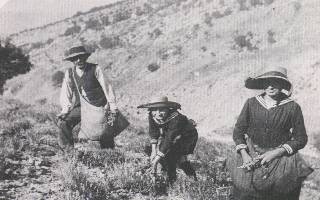

"… known since the Antiquity, native in the Mediteranean countries,
especially in France:
on the mountain hills of The Cévennes and the Maritime Alps…
…the former general name was "spic, or aspic…" the different
species were harvested together in the past.
In the 18 th century a separation according to different species was
made:
Lavandula spica (Linné)
Lavandula officinalis (Chaix)
Lavandula angustifolia (Monch)
Lavandula vulgaris (Lamarck)
Lavandula vera (De Candolle)
Lavandula spica DC (Lavandula vulgaris Beta Lamarck, Lavandula latifolia
Villars)
Lavandula dentata L.
Lavandula stoechas L.
The spic or aspic lavender essential oil was formerly only in France.
In the 16 th Century a difference was made between aspic and lavender
essential oil.
(F. de Gingens-Lassaraz, Histoire des Lavandes, Genève
et Paris 1826)
Lavandula Stoechas L., different with it's violet-red flowers, with
a a strong fragrance, is mentioned
in the writings of Dioscoride (Dioscoride, De materia medica
libri quinque), Pline (Naturalis historiae libri 37), Scribonius Largus
(Scribonius Largus Compositiones medicamentorum) and other authors
of the same era. The product they mentionned was however probably a maceration,
similar to other perfumed oils of the Antiquity. It's possible that the
Phoenecians, originating from Greece colonies, imported with other
herbs the Lavandula Stoechas, which spread throughout France and Spain.
They founded Marseille in 700 BC.
Everything seems to indicate that the Stoechas and Aspic oil were as
used in the Middle Ages as the Lavandula vera and the Lavandula latifolia
in the later periods.
The spic or aspic was already in use by the doctors of the Alexandria
school.
The essential oil of aspic was know from the 15 th Century on: it's
the only essential oil mentioned (except the "cèdre"(Turpentine)
by Jerome Brunschwig, in his book about distillation of 1500.
He mentioned it as Oleum de Spica, from the "Province" (Provence)
(Liber de arte destillandi, Vol 1, fol 72 ).
Saladin, at the end of the 15 e Century , also mentioned the distilled
Nard essential oil.
(Saladin, Compendium aromatoriorum, Veneti 1488. Index )
Valerius Cordus, in his Dispensatorium Noricum, in 1543, mentionned
only three essential oils:
Turpentine, juniper and aspic.
(Dispensatorium Noricum. Autore Valerio Cordo. Edit Paris 1548,
p 439…
"Ex majori lavandula que spica vocatur, apud nos majoribus sumptibus
fit quam in Gallia Narbonensi, ideo potius emendum est a mercatoribus qui
illud e Gallia afferunt" )
He added that they came from "The Province" in France, in small
bottles, at a high price…
In the 16 th Century, the Lavenders were already cultivated in
England and Germany.
Conrad Gesner used only the name of Aspic, and described the distillation
of the aspic flowers
(Conrad Gesner, De Hortis Germaniaeliber recens. Argentorati
1561), while JB Porta, at the end of the 16 e Century described
also the distillation of lavender, and marvels about the "French lavender"
(GBDella Porta, Magiae naturalis libri viginti. Liber de destillatione.
Romae 1567, fol 87 )
The medical books of the 13 e Century mention already "the Oleum spicae",
but it's only included in the first edition of the Dispensatorium Noricum
of 1543, the "Oleum lavandulae is only present in the 1589 edition, together
with the aspic and other essential oils.
The Pharmacopaea Augustana of Adolpho Occo only talks about Oleum spica
until 1613, the "Oleum lavandulae" is only mentioned with other essential
oils after this date. "
Cultivation:
All lavender and aspic oils were harvested from wild plants in the past. Many small scale working farmers found a way to survive in the dry regions of southern France. This work was done mainly during "spare time"by women, children, shepherds and others. This kind of harvest grew important around the end of the 19 th century and had a peak around 1920-1930.

(Image Christiane Meunier)
Meanwhile the culture of lavandin had a huge growth:
In 1924 production was 1-2 ton of essential oil.
In 1950 it production was already 200 ton and this grew between 1950
and 1980 from 500 to 1000 ton, a maximum level, since the production fell
down again since that moment.
 AGORA home page
AGORA home page Go to the FAQ pages............
Go to the FAQ pages............
 This site is hosted by Michel Vanhove
This site is hosted by Michel Vanhove